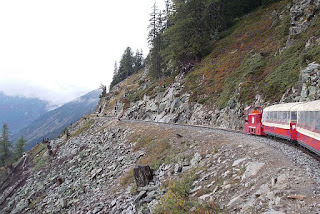 |
| The Trient Ravine has a sense of stepping back to the beginning of time (Taylor) |
Martigny
is best known by the Swiss for its numerous alpine ski slopes such as Verbier.
Lesser appreciated however, is that it is also a marvelous region for summer
activities.
Sitting
at a junction of roads connecting Italy, France and Switzerland, Martigny is
the gateway to Aosta over the St. Bernard Pass into Italy and to Chamonix in
France over the col de la Forclaz. Thus, Martigny is a perfect base for day
trips throughout Switzerland
Located
just 21 miles southeast of Montreux on the shores of Lake Geneva, Martigny lies
at the foot of the Swiss Alps on the eastern edge of the Rhone Valley Rhone River
makes a ninety degree turn in Martigny to flow north toward the Lake of Geneva ,
while the Dranse River
flows from the Valais Alps into the Rhone .
 |
| Boardwalk clings to the face of the ravine (Taylor) |
Therefore,
at an elevation of just over 1,500-feet, water plays a major role in the life
of the region as it does throughout the tiny landlocked nation of Switzerland
The most
notable attraction of Martigny is the Pierre Gianadda
Foundation Museum
When the
Romans departed the area they left many archaeological treasures in the city
including the amphitheater which was restored in 1978.
 |
| The Gianadda Foundation is the pride of Martigny (Taylor) |
When
Leonard Gianadda began clearing land for a rental property in 1976, he
discovered the ruins of an ancient Gallo-Roman temple on the property.
When his
brother Pierre died unexpectedly soon
after the Roman excavations, Leonard began developing what has become
Martigny's most prized cultural attraction in honor of his sibling.
 |
| The outdoor sculpture park is filled with landscape architecture and contemporary artwork (Taylor) |
Outside,
at the rear of the contemporary building, are the Sculpture Park, Chagall Court
and the Szafran Pavillion all set among landscape architecture featuring
fountains, hedges and works of art by 20th century artists.
Rounding
out the eclectic collection of exhibitions in the interior are the Greco-Roman
Museum, a two-level expanse that incorporates the excavations that are the
oldest of their kind in Switzerland, an Automobile Museum featuring over 50
classic cars dating between 1897 and 1939 and space for temporary traveling
exhibitions created from various private collections.
 |
| Excavated Roman ruins (Taylor) |
The
richness of the displays and importance of the Giannada
Museum to Martigny justifiably lives
up to the town nickname which is the "Art City
 |
| Vintage cars are a favorite exhibit at Gianadda (Taylor) |
Each
year in October at the local festival known as the "Comptoir" the
amphitheater plays host to non-lethal cow fights that pit animal against animal
rather than animals against humans.
Just
outside the city-proper, there are other compelling natural and manmade
attractions for visitors to experience before heading off to nearby France and Italy
 |
| The Trient Ravine is more than 650-feet deep (Taylor) |
Among
the natural wonders is the Trient Ravine with its impressive water landscape
that was carved into the rock by a rushing mountain stream from the Mont Blanc massif.
The
655-foot ravine, a favorite spot for climbers, hikers and nature lovers, is
like stepping into Jules Verne's "Journey to the Center of the Earth"
with its eerie canyon walls and wooden
walkway that hugs the perimeter of the rock-face.
 |
| Pissevache Waterfall is part of the natural wonder (wikipedia.com) |
Over
600-feet above the canyon floor, a bridge spans the chiseled gorge with its
source from the glacier above the town of Trient ,
near the border of France
It's an
other worldly atmosphere with a primeval sense of being at the beginning of
creation.
At the summit, the Mont Blanc Express train climbs steeply into theTrient Valley
past the cascading waters of the 375-foot “Pissevache” waterfall before
arriving at Chamonix in France
Not far
from the Trient Ravine is the three stage lift system known as the "Verticalp" experience that takes visitors to the Emosson Dam. The
combination funicular/train journey incorporates a panoramic train with one of
the steepest funicular rides in the world that features an 87-degree incline.
The most impressive portion of the journey is the bottom leg where a funicular climbs almost vertically up the mountain high above thevillage of Chatelard
 |
| Cliff hugging trains will get you to the summit (Taylor) |
At the summit, the Mont Blanc Express train climbs steeply into the
 |
| The Verticalp Funicular is one of the steepest in the world (Taylor) |
 |
| Wildflowers seem to reach up to touch the sky (Taylor) |
The most impressive portion of the journey is the bottom leg where a funicular climbs almost vertically up the mountain high above the
When the
Chatelard Funicular reaches its terminus, a tiny narrow gauge open-air train
snakes along the mountainside that is filled with majestic views of Mont Blanc .
The
final phase of the journey is a short ride in a bright red funicular that stops
at the Emosson Dam and Reservoir which captures water from three glaciers.
 |
| A tiny red funicular completes the journey to the summit (Taylor) |
Located
on the left bank of the Rhone above Martigny and fed by water from the Mont
Blanc massif, the Emosson Dam is the third highest in Switzerland
Breathtaking
scenery, beguiling transportation, a cavernous gorge, eclectic art, historic
ruins, classic automobiles and the close proximity to Italy and France










1 comments:
Hello, I am a Korean living in Seoul.The postings on the blog were helpful. Do you usually write articles right after you visit the area?
Post a Comment